Imagine sitting on the bank of a Mallee dam, red dirt at your feet, flies at your eyes, and Crimson Chats warily walking towards the water – absolute bliss!
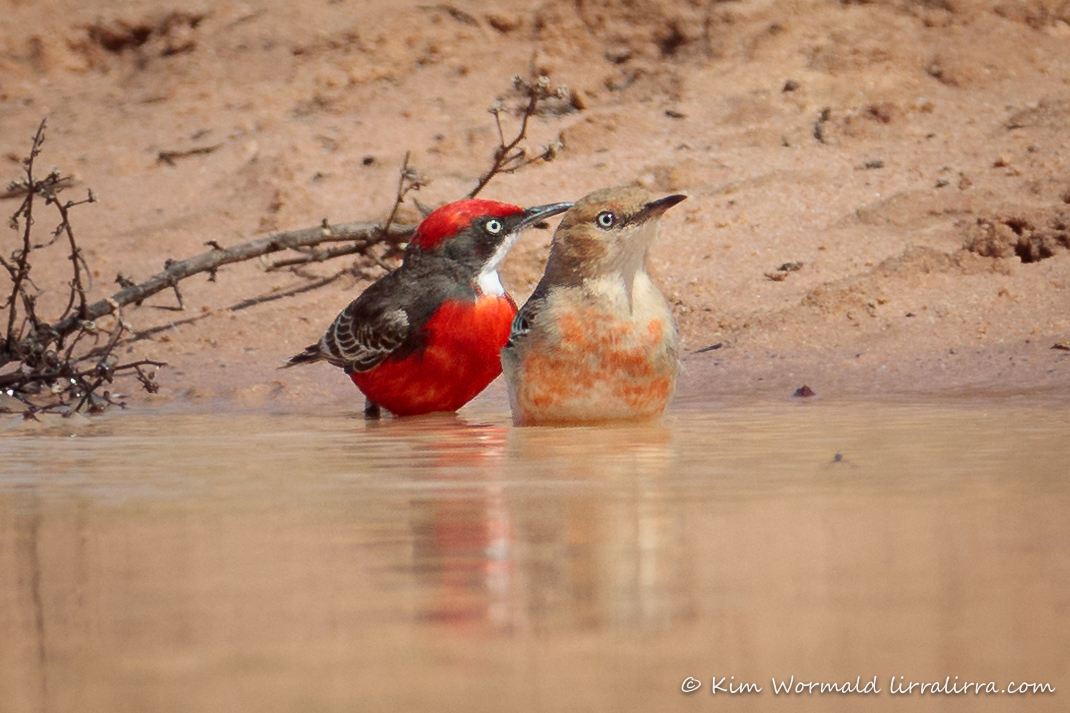 Crimson Chat (Epthianura tricolor) – breeding male and female
Crimson Chat (Epthianura tricolor) – breeding male and female
1/2000, f/6.3, ISO 400, focal length 560mm
Canon 5DsR, Canon 200-400 L IS USM EXT
In recent weeks there has been an irruption of Crimson Chats into areas further south than they are usually seen. This happens in times of drought when the saltbush doesn’t fruit and invertebrates are in short supply; this year they have come a long way south.
Crimson Chats are a small, insect-eating species that measure about 12cm and weigh about 11g. They walk rather than hop, so were quite comical to watch as they made their way to the water’s edge.
Birds are vulnerable when they drink and even more vulnerable when they take the time to bathe. This beautiful pair checked the area before taking the plunge, watching a distant raven.
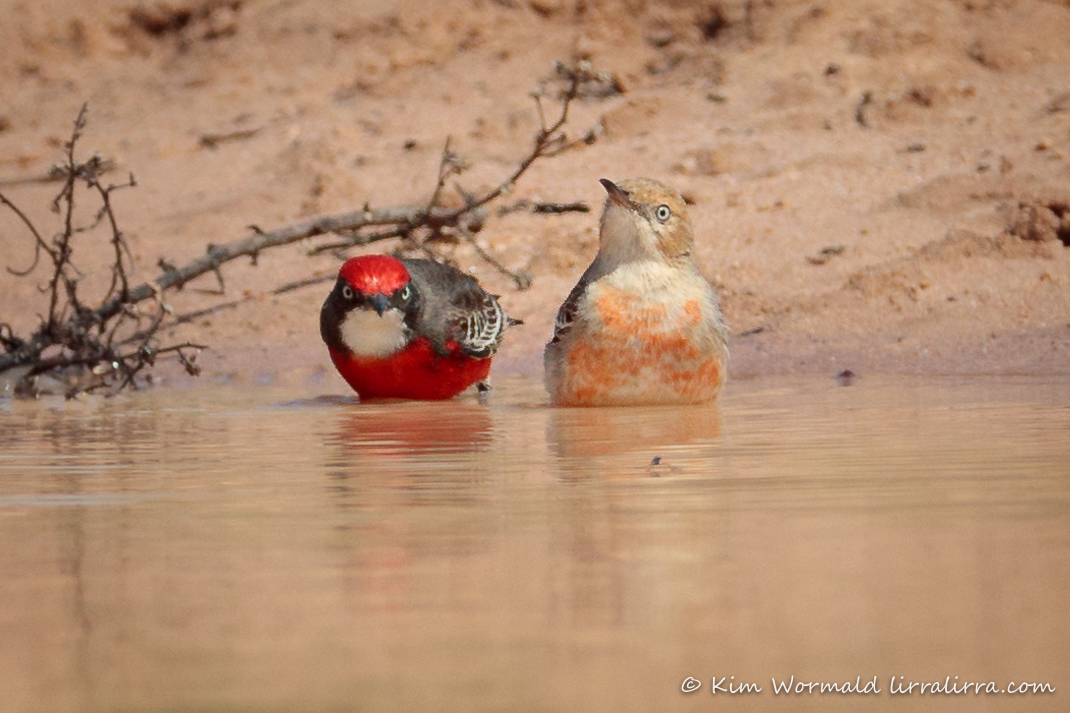 Crimson Chat (Epthianura tricolor)
Crimson Chat (Epthianura tricolor)
1/2000, f/6.3, ISO 400, focal length 560mm
Canon 5DsR, Canon 200-400 L IS USM EXT
The male ducked first for his bath. It’s a large dam and he seems to be looking just to my right, I was snuggled beneath my Realtree fabric hide.
Breeding male Crimson Chats have bright red heads, underparts and rumps that are set off perfectly by their black face mask and white throat. They have white edges to their wing feathers, pale irises and slightly down-curved bills.
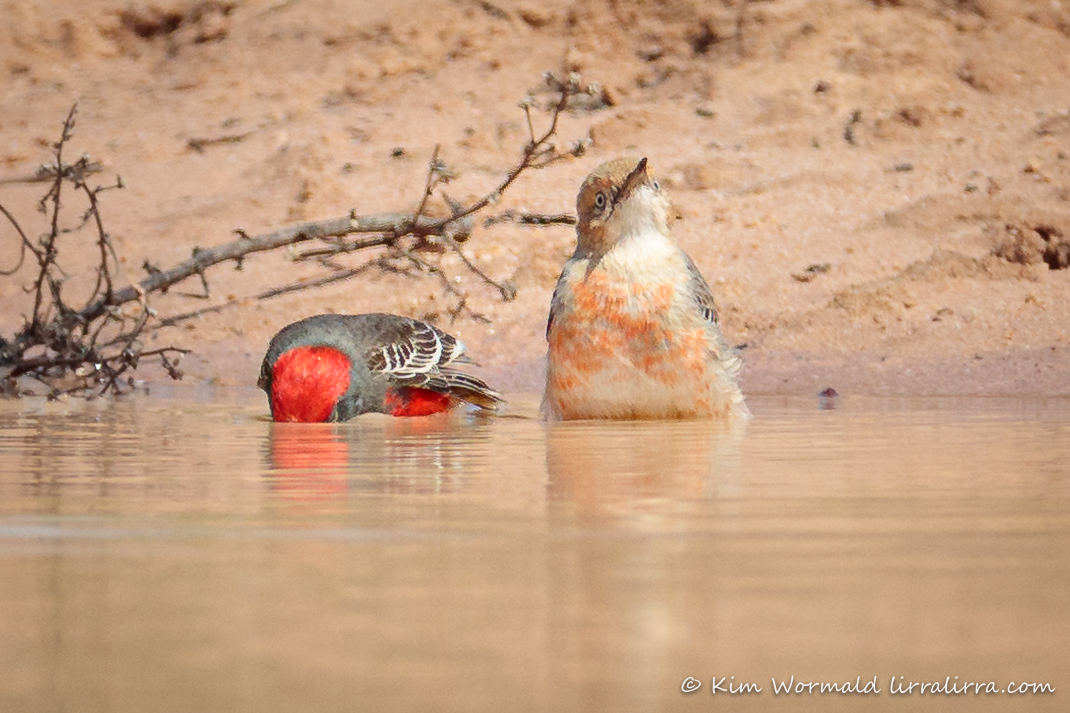 Crimson Chat (Epthianura tricolor)
Crimson Chat (Epthianura tricolor)
1/2000, f/6.3, ISO 400, focal length 560mm
Canon 5DsR, Canon 200-400 L IS USM EXT
As the male plunges into the water the female keeps watch; there is no cover for them at this dam. Females in their breeding plumage retain their red uppertail coverts and develop reddish patches on their underparts.
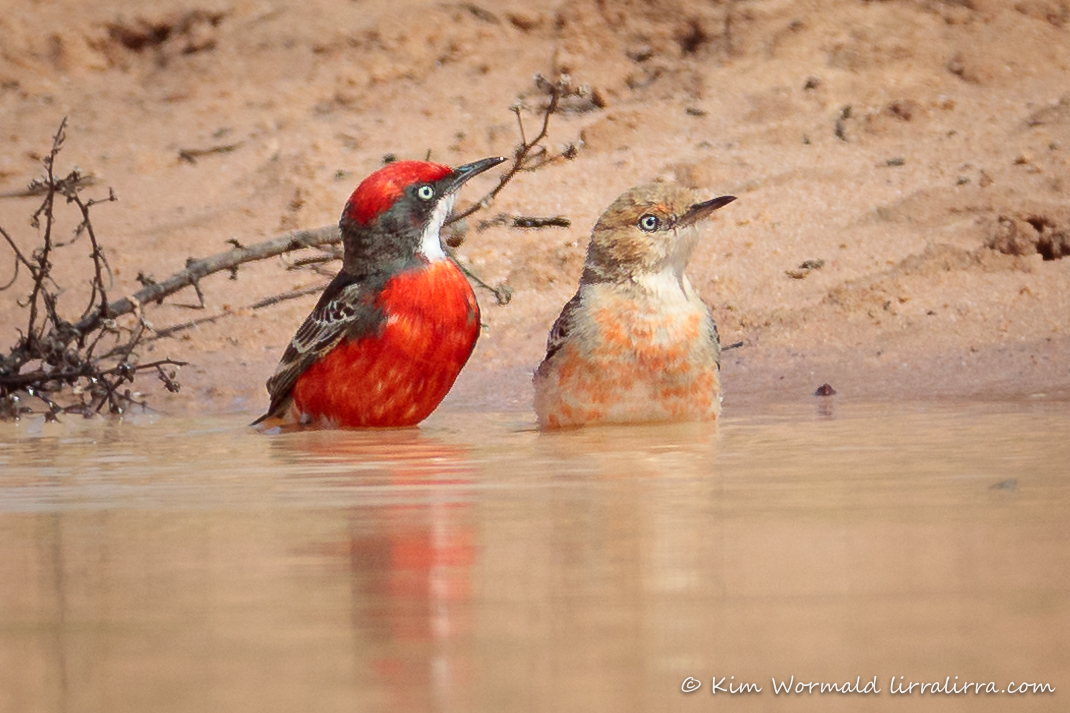 Crimson Chat (Epthianura tricolor)
Crimson Chat (Epthianura tricolor)
1/2000, f/6.3, ISO 400, focal length 560mm
Canon 5DsR, Canon 200-400 L IS USM EXT
They remain very watchful during their bathing session. I didn’t see any raptors at the time but there were ravens calling to their left so I assume they were making sure the larger birds weren’t heading closer.
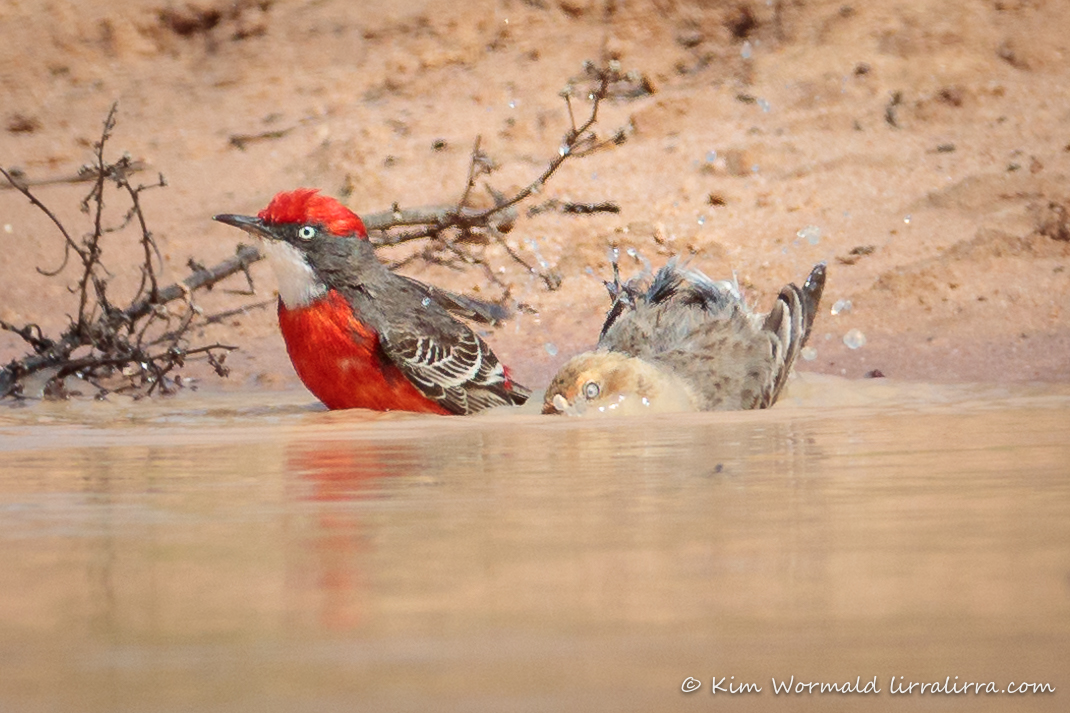 Crimson Chat (Epthianura tricolor)
Crimson Chat (Epthianura tricolor)
1/2000, f/6.3, ISO 400, focal length 560mm
Canon 5DsR, Canon 200-400 L IS USM EXT
Then it was the female’s turn to bathe, sending water droplets flying, while the male kept watch. Bathing helps to cool birds and control parasites.
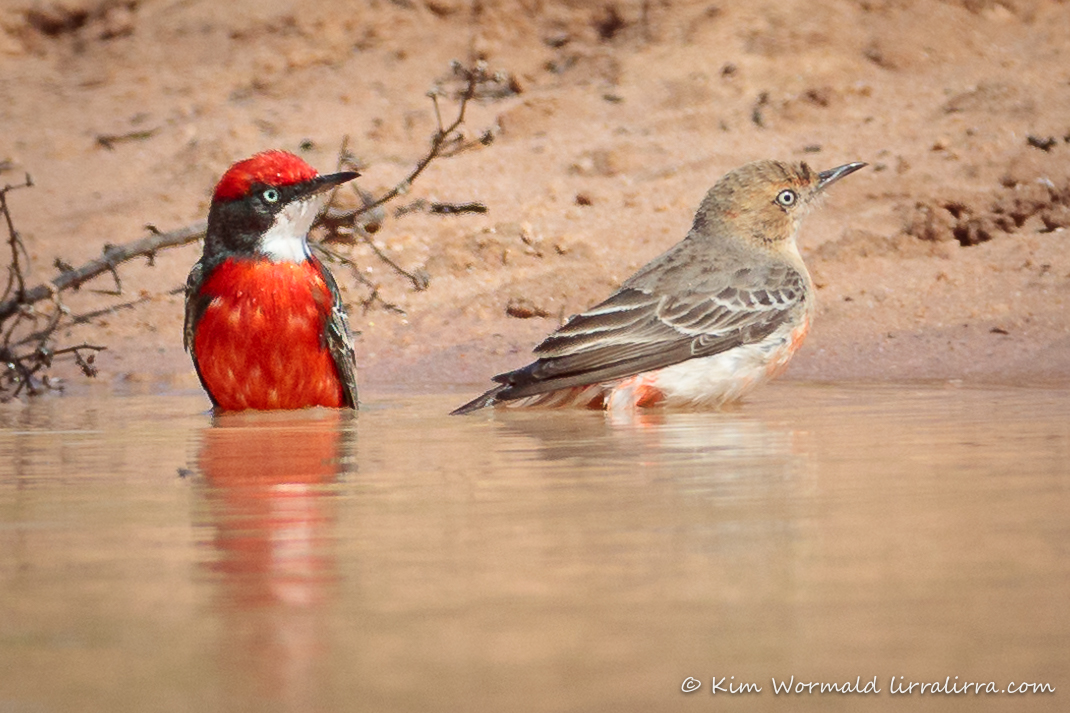 Crimson Chat (Epthianura tricolor)
Crimson Chat (Epthianura tricolor)
1/2000, f/6.3, ISO 400, focal length 560mm
Canon 5DsR, Canon 200-400 L IS USM EXT
I enjoy taking photographs of birds behaving naturally. They were clearly not bothered by me and I would never risk disturbing them by using a flash, the bird is always more important than the photograph.
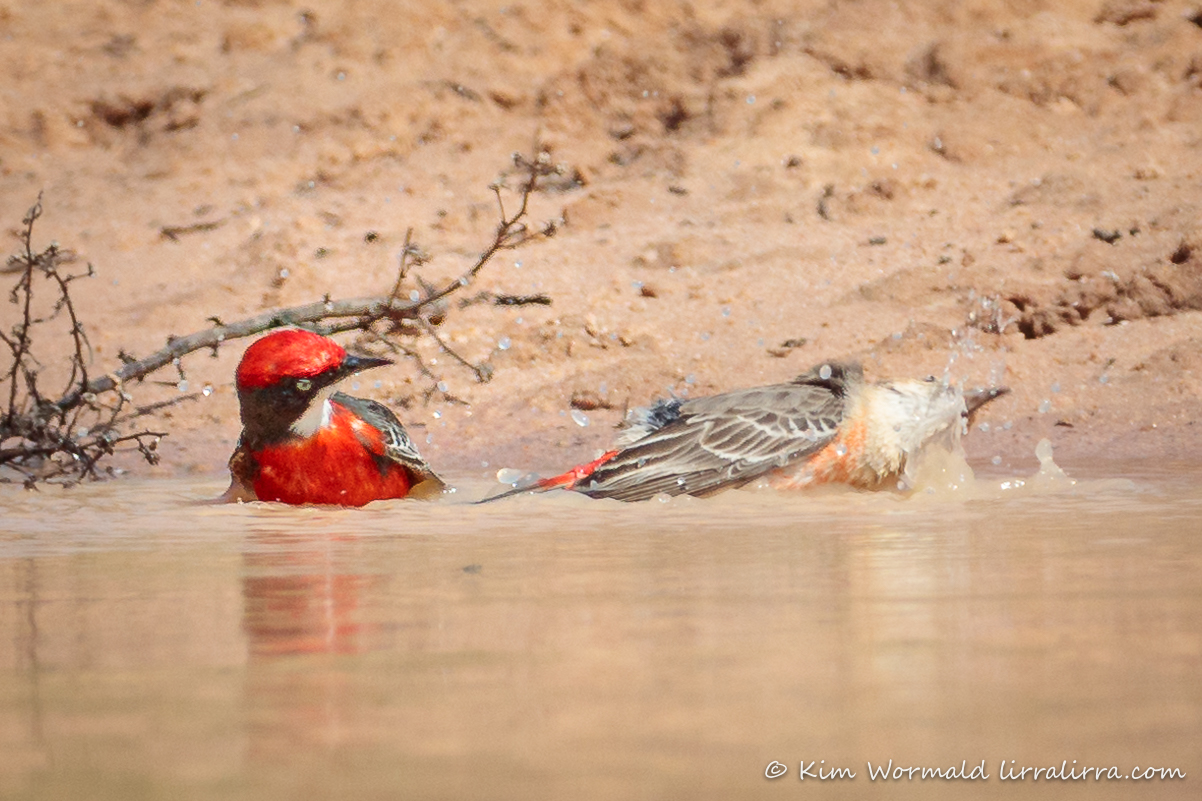 Crimson Chat (Epthianura tricolor)
Crimson Chat (Epthianura tricolor)
1/2000, f/6.3, ISO 400, focal length 560mm
Canon 5DsR, Canon 200-400 L IS USM EXT
The way the female is bathing and the male’s expression in the photograph above makes me smile. This week’s images are heavily cropped, going from an initial pixel size of 8688×5792 to 1070×713.
Several years ago I spent many hours hoping to see these beautiful little birds at Lake Mungo, all I saw was a tantalising flash of red that was so fleeting that I wasn’t entirely sure I’d actually seen it. I feel incredibly lucky to have spent so much time with them in the Mallee.
Happy birding
Kim
~ If interested please like my new Facebook page: Kim Wormald – lirralirra and join Ethical Bird Photography ~ thank you
~ For a weekly email saying lirralirra has been updated please subscribe above

What gorgeous little birds!!
They really are exquisite
Wow. Beautiful birds. Interesting that the male went first. No chivalry there. Great pictures.
That’s a funny thought Elizabeth! You’ve got me wondering what excuses he’d make, like testing the water temperature or checking for predators
Ooo they are stunning! How special to see this pair of bathing beauties.
I was so lucky Alyssa and I’m still smiling.
What absolute stunners. I am glad that you saw them (and captured them so we too can marvel at them) but so very sorry that the drought has forced them to travel long distances.
I feel the same EC. I hope they get some decent rains in the drought areas, soon. It’s raining here again and still to wet to mow, I wish it could be shared with the northern dry spots.
Such beautiful photos, once again. I enjoyed them immensely, and had the identical reaction to you, as I look at the expression of the male bird watching the female bathing!
It was so good to see a bird that I’ve looked for, for so many years. How strange does ‘for for’ look in that sentence! I shall go back and add a comma. The funny expression image looks like it’s waiting for a comical caption.
Such beautiful pictures Kim, thank you once more for brightening my Friday. Warm regards, Alison
I’m happy to have had the chance to brighten your Friday Alison, Kim
Kim these are delightful photos. Thankyou for sharing.
Thank you for your kind comment Mary, Kim
I enjoyed much the same experience at Hopetoun a couple of weeks ago.
Not having a hide, I just sat under a small gum tree and watched the birds come quite close at times.
It was terrific watching them, and I got some great shots too.
That’s great Christopher. It is so relaxing and heart-warming to sit and watch such beautiful birds.
Really beautiful photographs,Kim. Such a wonderful encounter.
Thank you so much Jane, Kim
Hi Kim,
I too, have been fortunate to have been able to make the trip up into the mallee this year to witness the irruption of Crimson Chats to the south following water and food (insects).
How can we ever turn back the clock and get farmers to stop using insecticides and allow our birds to do the job that they do better than any chemical could ever do??
Kind regards,
Bruce
Over the years I’ve read some beaut articles about farmers planting wildlife corridors and hedgerows to encourage birds and predatory insects like ladybirds. Like you I definitely hope for a reduction in the use of chemicals, it’s essential.
Incredible photos Kim. Congratulations!
Thank you Andrew, it was so magical to watch them bathing